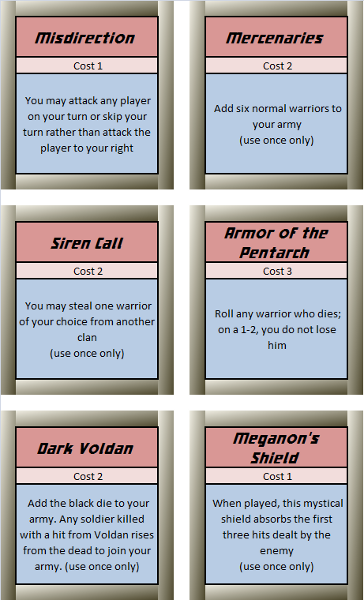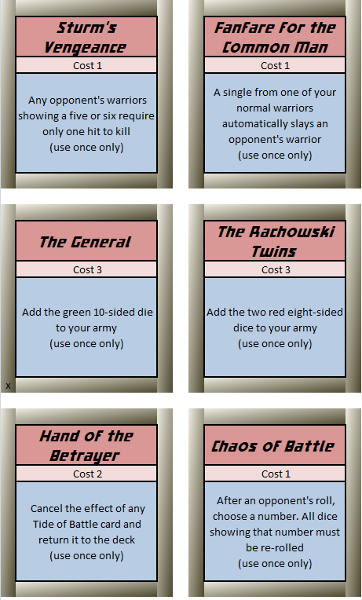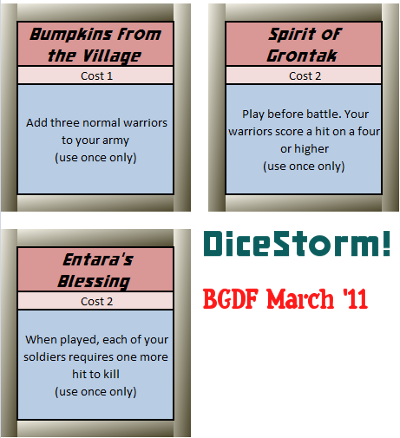Short analysis - I didn't place in the top five, which is all the results they gave. I was sad, because the game is a lot of fun, is complex, and seems well-balanced, and some of the other entries that placed don't seem like they would be.
Long analysis - I found myself wondering, as I often do upon hearing contest results, why my game didn't do better. I've entered a number of game design competitions, and of these, Hippodice and the Rio Grande competition last fall were the only ones I've gotten feedback from. Occasionally I get some feedback from the monthly BGDF design showdowns (though not from people who've actually played the game, since the entry is just an 800-word description/rules document with a couple small pictures).
The feedback from Hippodice was very brief, although I was very grateful that they took the time to send it (I'll need to post that here sometime to show what they do). The feedback from the Rio Grande competition made it clear that the judges had left out a key component (trading) to the game they were playing (Yoggity), a component that changes the game from mostly luck-based to very strategic.
So, what did I learn from this TheGameCrafter.com competition? Hard to say, with no feedback other than not making it. If I've followed the progress of judging correctly, the final five were the only ones actually created and played by the judges. The rest (including mine) I assume were judged based on rules, artwork, and presentation. The standards and system they used for judging the final version wasn't in the original announcement of the contest, so there'd have been no way to tweak the game toward the judging.
I guess what I'm getting at is some advice to myself: don't enter the contests to get feedback about your games. The only feedback you're likely to get is very simple - you won, or you lost, or maybe, if you're lucky, some placement information. Who wins and loses depends on how good your game is, certainly, but it also depends on what standards they're using (which you don't always know), how the judges interpret those standards (which you can't know), and a host of other idiosyncratic factors, like whether the judges' taste matches your theme or your art or your complexity level, whether they've just played a bunch of games like yours - all stuff you can't know and can't control.
So, if you're not entering to get feedback (a lesson I need to learn), then why enter? The only valid reasons I can see are:
- A reason to design a game, and a deadline to design it by
- The thrill of the competition
- A chance to gain free exposure for your game (very unlikely unless you win a prestigious contest)
- A prize (seldom offered, but cool when it is)
#1 - a reason to design - is a good benefit for me - I like working on games, and having the restrictions and deadlines for competitions helps me focus.
I get a lot of #2, the excitement, also, although when the judging is seemingly more random (or maybe just more hidden) that tends to dampen the thrill. In many of these contests, too, it's very difficult to know what your competitor's games are like, which makes it difficult to evaluate the results - you don't know whether to feel righteously thrashed by superior design or bitter and unappreciated. That's one of the great things about the BGDF showdowns - you get to see everybody's whole entry, and they're short enough that you can read and understand them all.
#3 (exposure) and #4 (a prize) I haven't won enough to see. The BGDF showdowns, of which I've won a few, offer no prize and nearly no exposure. The bigger ones would certainly do more, sometimes even the holy grail of publication, but I've only entered a few of those.
So, I think I have to content myself with practice designing and the excitement of competition, and let the rest of it go. Obviously, as I've seen, even in a competition, people aren't going to have a chance to get to know your game well, and may not even play it, so it's not really much of a measure of how "good" it is. But good rules and good graphical presentation are key, because that's something that even the most rushed judges are going to take a look at.
























